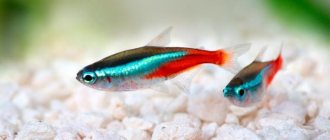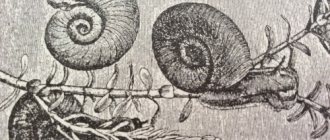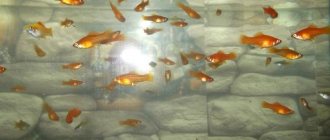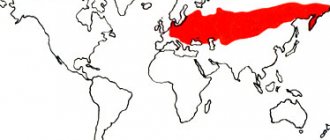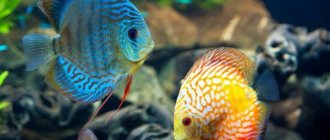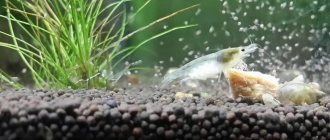The Neon aquarium fish has been known for a long time, but its popularity is still at its peak these days. The mesmerizing flock is an indescribable spectacle. Few can compare with the beauty of Neons, and the friendliness of underwater inhabitants and their ability to easily adapt to their environment make the fish ideal pets.
But still, to maintain them you need to know some nuances. In this article we will describe what is needed for maintenance, what to feed, and what is needed for reproduction.
Aquarium fish Neons photo and description
A miniature fish about 4 cm in size. They live for about 3-4 years. A distinctive feature is a bright luminous stripe on the sides of most types of Neon; it is visible along the entire body. The different subspecies are distinguished by all sorts of color variations of this stripe, supplemented by some color details.
Very active fish that prefer to stay in a school. By creating harmonious living conditions, you can achieve the most vibrant colors and enjoy the magnificent view of these underwater inhabitants.
Compatibility
Common neons have good compatibility with other fish. However, you should not place them in the same aquarium with larger individuals, especially predators. Despite the nimbleness of small exotic fish, they can become victims of aggressors. Neons sleep at night, and their shiny stripes on their bodies attract special attention.
The compatibility table for neons clearly shows who should be preferred as neighbors.
Provided that different fish will be placed in one artificial reservoir, then for blue neon you should select peace-loving neighbors, of similar size and not excessively active.
For a comfortable rest for the fish, you need to ensure that there are dense thickets of plants at the bottom of the container. They can be either natural or artificial. It is not recommended to add fish that feed on aquatic vegetation to neons. Living plants maintain the necessary stability of the aquatic environment, absorb harmful compounds and provide shelter for small inhabitants.
In a densely planted aquarium, it is necessary to leave a swimming area. Neons love actively overgrown bodies of water.
Aquarium fish Neons maintenance and care
As mentioned earlier, the fish are very unpretentious, but Neons can only be introduced into a well-established aquarium, in which fluctuations are minimized. The optimal water indicators are 7 pH, and the hardness is not higher than 10° dH.
An important point in keeping is to have a place in the aquarium where you can hide. Abundant thickets of algae and floating plants, which can create shelter on the surface of the water, are suitable for these purposes.
A sense of security is a necessary condition for the comfort of fish.
There are no special requirements for the soil. From an aesthetic point of view, it is recommended to choose a dark-colored primer. According to experts, with it the aquarium in which Neons live will look as impressive as possible.
In principle, maintenance is quite simple and does not require much effort on the part of the owner. It is important to maintain the temperature at +22-26° C. For purification, various filtration systems are used and a quarter of the water is replaced weekly.
To achieve the most aesthetic appearance of an aquarium with Neons, it is worth planting it densely with plants, for example, various types of sagittaria, Vallisneria nana, Vindelova fern and many others. You can add decorative elements.
Motherland
Neon fish originated from South America. This is where their homeland is, where they live in clean reservoirs with soft water. They are also found in the rivers of southeastern Colombia and eastern Peru. They love shade, so they choose places with dense vegetation, where the sun's rays practically do not reach. They live in groups of 10 or more, so they should never be kept alone in an aquarium as they rely on each other.
The reservoirs of the Amazon River basin are native to neon birds.
The first neon fish imported into France in 1934 sold for $6,500.
What to feed Neon fish
For picky fish, you can use daphnia and dry gammarus as food.
Live food is most often used as an additional treat. Diet variety will help maintain health, stimulate growth, and achieve bright neon colors.
It is important not only to feed the fish, it is also important to feed them correctly. Optimally – 1-2 times a day. The main cause of many diseases, and even death, is overfeeding. After feeding, any remaining food must be removed.
In addition, when choosing a neighborhood for your pets, you should pay attention to the similarity of their gastronomic needs.
Diet: bloodworms, cyclops, daphnia, enchytraea, gammarus. Industrial feed is acceptable.
Neon's anatomical feature is a small mouth, so it is important to select medium-sized food that the fish can swallow.
Table of basic parameters of maintenance, care and nutrition:
| What should be the volume of an aquarium for Neon? | from 10 liters for a pair of Neons for a flock from 50 liters (also depends on the type) |
| What should be the temperature in the aquarium for Neon? | from +20-31° C |
| What pH should be in the aquarium? | from 5-8 pH |
| What should be the hardness of the water in the aquarium? | up to 15° dH |
| What should be the substrate for an aquarium? | any |
| What kind of lighting should be in the aquarium? | 0.5-0.8 Watt/l daylight for at least 12 hours |
| What should be the movement of water in the aquarium? | moderate |
| Maximum size of Neon | up to 5 cm |
| What does aquarium fish eat? | dry food, daphnia, tubifex, bloodworms |
| Type of aquarium fish | non-aggressive |
| Who is compatible with in an aquarium? | get along with small non-aggressive fish species and shrimp; |
| Lifespan | from 3-5 years |
For most types of Neons, the rule is: 1 liter of aquarium per 1 individual. For example, in a 10 liter aquarium you can add 10 Neons. But for a comfortable, painless life, it is better to house 6-7 individuals.
Health
Neons have the ability to lose their brightness during the night. This makes them less accessible to predators. But if the color disappears during the daytime, this may mean that the fish is sick.
The reasons that can affect the health of individuals can be different:
- insufficient oxygen;
- improper feeding (usually overfeeding);
- water temperature (below 15-16 C°);
- water pollution;
- pathogens.
Neons are most often susceptible to the following diseases:
Plistiphorosis
This is the most common disease that kills neon fish. Its second name is “neon disease”. The fungus affects the muscles. The first symptom is a pale color and neon stripe. As the disease progresses, the fish becomes completely discolored and swims on its side or upside down. Then he dies. The disease is contagious, so the sick individual must be quarantined or killed. There is no treatment.
Saprolegniosis
The causative agent is also a fungus. The main causes of infection are poor aquarium hygiene, unbalanced nutrition and overcrowding. You can notice that the fish is sick by a spore-like coating and gluing of the fins.
False neon disease
The disease received its name due to the common symptoms with plistiphorosis. Only the causative agent is the bacterium Nocardia asteroides. The neon fades, the bright stripe disappears, and a whitish coating appears over the entire surface.
To prevent any disease, it is important to follow all maintenance rules. Do not overfeed, maintain the correct temperature, and perform water changes.
Lifespan
How long a neon fish will live depends directly on the water temperature. Thus, at temperatures above + 26 °C, fish quickly age and live no more than 1.5 years. Therefore, it is better to keep them in water at 20-24 C°. Then their life expectancy will double or triple, that is, the neon will be able to live 3-5 years. The period of puberty occurs in males and females of neon at 6-9 months, after which they can breed in an amateur aquarium.
Neons types with names and descriptions
Small fish that shimmer in different colors have been considered the most popular among aquarists for many years. All possible color options will not leave anyone indifferent.
Neon red
The female Neon red reaches 4.5-5 cm in length, the males 2.5-3 cm. The red stripe is more saturated in color, it is somewhat wider than that of the ordinary Neon.
It is customary to keep peaceful fish in small groups and avoid the company of predatory fish. Life expectancy is 3-5 years in an aquarium. Temperature from +23-26 ° C, acidity from 6-7 pH, hardness up to 5 ° dH. 6 individuals require an aquarium of 60 liters.
Neon green
Neon is green; the greenish tint of the back is combined with a white belly. The fins are colorless. The length rarely exceeds 4-4.5 cm. For a pair of green Neons you need an aquarium of 15-20 liters.
It is acceptable to keep such a pet in a small aquarium in the vicinity of other species. The peaceful fish is very mobile and can jump out of the water, so you should take care of its safety and cover the aquarium with a lid. Temperature from +22-26° C, acidity from 5-6 pH, hardness from 2-8° dH. With proper maintenance, life expectancy is up to 5 years.
Neon blue
Neon blue also has a name - ordinary. This Neon has a slender body with a shining blue stripe on the sides. Almost transparent fins add contrast to the expressive body. Grows up to 4 centimeters. A flock of 10 blue Neons requires an aquarium of at least 50 liters.
Perhaps this is the most popular fish, which is very often kept by aquarium lovers. It is unpretentious, which makes it an ideal option for beginners. Temperature from +20-25° C, acidity from 5-7 pH, hardness from 1-10° dH. With proper maintenance, life expectancy is up to 5 years.
Neon black
The main distinguishing feature of Black Neon is its color. A luminous golden-green stripe is visible along the sides, the color of the back is approaching brown. The presence of an additional black stripe was the reason for giving the fish this name. Black Neon grows up to 4 cm. For a flock of 10 black Neons, you need an aquarium of 60 liters.
The conditions in the aquarium should be: temperature from +20-25° C, acidity from 6-8 pH, hardness from 5.5-15° dH. When maintained in all conditions, life expectancy is from 3 to 5 years.
Neon blue
Blue Neon, like other types of Neons, prefer to stay in flocks and not conflict with other inhabitants of the aquarium. The size of a female Neon is up to 3.5 cm, and a male is from 1.5-2 cm. For a flock of 15 blue Neons, you need an aquarium of 50 liters or more.
The conditions in the aquarium should be: temperature from +22-26° C, acidity from 5-6 pH, hardness from 1-4° dH. When maintained under all conditions, life expectancy is up to 5 years.
Neon gold
A representative of this species is essentially another variation. From the name you can guess that the body has a golden color. The usual stripe running along the entire body is combined with a turquoise frame of the eyes. Golden Neon can create a very impressive look for the underwater kingdom, especially if kept in a school. The optimal number of individuals is 7-9 pieces. The maximum size of golden neon is up to 1.5 cm. A flock of 6 individuals requires an aquarium of 15 liters.
The temperature in the aquarium should be from +22-26° C. The acidity of the water is from 5.8-7.5 pH. Water hardness up to 15° dH. Lives in an aquarium for up to 4 years.
Neon savannah
Perhaps the Savannah Neon is the hardiest type of Neon. An ideal candidate for a community aquarium. The place of natural habitat in the wild was the reason to give the fish this name.
They can grow up to a maximum of 2-3 cm. They are painted gray, the usual stripe glows.
Despite their unpretentiousness and high adaptability, they are sensitive to water quality. It is important to control its parameters and try to create optimal and comfortable conditions for the fish. Temperature from +20-25° C, acidity from 5.5-7.5 pH, hardness from 1-12° dH. A flock of 10 or more individuals needs an aquarium of 50 liters or more.
If these requirements are met, reproduction is possible all year round. It is necessary to plant a couple so that they do not eat the eggs.
Neon diamond or diamond
Diamond or diamond neon was created artificially. The head is blue. The red stripe extends to the tail. The main color of diamond neon is silver, with a bluish tint. Perhaps these are the only representatives of Neons that are distinguished by the fact that they are territorial. For 6 individuals you need an aquarium of 15-20 liters.
Maximum length up to 3-3.5 cm. Temperature for maintenance should be from +23-27° C. Acidity from 6-7 pH. The water hardness in the aquarium should be between 3-12° dH. Life expectancy is up to 3-4 years.
Neon lilac Kerry
The body length of Lilac Neon reaches a maximum of 3.5 cm. They are distinguished by a peaceful disposition and are very unpretentious in care. They are easily bred, without requiring extremely difficult conditions for this.
The lilac color dominates the coloring with a hint of purple, and a dark stripe stretches along the body. Bright males look most impressive; females usually appear in more subdued colors. Their colors are predominantly brown and yellow. A flock of 10 Kerry nens needs an aquarium of at least 50 liters.
For maintenance, a temperature of +24-27° C is required. Acidity is from 5.5-7 pH. The water hardness in the aquarium should be between 1-12° dH. Under these conditions, Neon Kerry lives from 3-5 years.
Neon Erythrozonus
Neon Erythrozonus is a small aquarium fish up to 4 cm in size, attracted by the presence of a bright orange neon stripe. What makes it unique is the base color, which is almost completely transparent. With age, the color becomes more pronounced, and the fish takes on an even more attractive appearance. A flock of 6-7 Neons Erythrosonus needs an aquarium of at least 60 liters.
The water temperature in the aquarium is from +22-26° C. The acidity in the aquarium is from 6.5-7.5 pH. Hardness in the aquarium is from 4-12° dH. Under these conditions, Neon Erythrozonus lives up to 5 years.
Neon blue eyes
The aquarium pet is very common. Quite unpretentious, they produce offspring in captivity. They live in an aquarium in a flock of 8 individuals in an aquarium of 40 liters and at a temperature of +21-31° C, acidity of 7-8 pH, and water hardness of 10-26° dH. In brackish water, the blue-eyed neon lives much longer and feels more energetic.
The maximum body size usually does not exceed 3-4 cm. The color is yellow and blue, the back has a neon sheen. Females have a calmer color option. If in almost all species of Neons the females are larger, then in the blue-eyed Neon the opposite is true - the males are larger with a brighter color.
Neon tricolor (Heterorabdus)
Neon tricolor grows up to 4.5 cm. Its characteristic color is a black-golden-red stripe and a silver belly. Because of the longitudinal stripe consisting of three colors along the body, the fish got its name. In some literature you can find the name - the Belgian flag.
Tricolor Neon is a schooling fish that is comfortable in a school of 6 or more individuals and in an aquarium of 60 liters or more. With temperatures from +23-26° C, acidity up to 6.5 pH and water hardness from 3-4° dH.
Neon platinum
Platinum neon has a second name - gold Tetras. Scales with a golden tint highlight aquatic inhabitants. Guanine, located under the skin, not only provides it with a unique color, but also protects it from parasitic organisms that could cause harm to health.
In captivity, Platinum Neon reaches up to 4.5 cm. A couple of platinum fish can be kept in an aquarium of 10 liters or more, but Neons are schooling fish. The flock should consist of 10-20 individuals and the aquarium should be at least 100 liters. The temperature in the aquarium is from +24-28° C, the acidity is from 6-7 pH and the water hardness is from 2-12° dH.
They retain the ability to reproduce, but it is almost impossible to preserve their unique natural color. Under artificial conditions, the fish becomes silver.
Neon Peruvian (Hifessobricon Loreto)
Peruvian neons reproduce without difficulty in captivity. They do not require special conditions and get along with a wide variety of non-aggressive underwater inhabitants. Grows from 3-4 cm.
The body is grayish-silver. The longitudinal stripe has a dark color, which is complemented by a unique golden-neon touch.
For 10 individuals you need an aquarium of 60 liters. The temperature in the aquarium should be +22-27° C, acidity from 5-7 pH and water hardness from 2-10° dH. Life expectancy is up to 2-3 years.
Neon Boelka, Blue Tetra, Belkea (Boehlkea fredcochui)
This type of Neon is called differently: Boelka, Boelka bluish, Blue tetra, Belkea (Boehlkea fredcochui). Appearance is characterized by a silver body with a magnificent neon tint close to blue. Despite the maximum size of 5 cm, it is quite difficult to keep such Neons in a home aquarium.
To keep a pair of Neons you need an aquarium of 15-20 liters. For a flock of 10 individuals, you need an aquarium of 80 liters and a temperature of +22-27 ° C, acidity from 5-7 pH and water hardness up to 15 ° dH. Life expectancy is up to 2-3 years.
Neon voile
Neon veil is a rare specimen that was bred artificially; this species does not exist in nature. Due to the long veil, decorations in the aquarium need to be minimized.
The size of the female reaches up to 4 cm, the male is 0.5-1 cm smaller. To keep 4 veil Neons you need an aquarium of at least 10 liters. Temperature +23-24° C, acidity from 6.5-7 pH and water hardness from 5-7° dH. Life expectancy is up to 3-5 years.
STORY
For the discovery of neons and their appearance in our aquariums, we should thank the French researcher Auguste Rabot. It was he who first discovered these fish in Peru, in the Putumayo River. The beauty of the fish literally bewitched Auguste. Being a very enterprising man with a touch of adventurism in his soul, he decided that he could make good money by exporting them.
In 1935, the first copies of neon were first delivered to Europe and the USA. Aquarists really immediately fell in love with these fish, they became very popular. The fact that neons did not require complex maintenance was an additional plus. Auguste Rabot received huge dividends from his find. The fact is that in artificial conditions problems arose with the breeding of neons. In the first years, no one simply succeeded, so Rabo became a monopolist in the supply of neon to Europe.
Some of the first copies were donated for advertising purposes to William Innesi, an aquarium enthusiast and popularizer. He, in turn, gave the fish to his friend, George Myers, who made the first scientific description of a new species - blue, or ordinary neon, which he named in honor of his friend.
For the first time, it was possible to obtain offspring under artificial conditions in Germany. This phenomenon was even called the “German miracle.” Over time, it became clear that the secret of this “miracle” was in the softness of the water that was used to contain neons. The information obtained served as an impetus for new research that discovered the mechanisms of influence on the successful reproduction of neons.
Neons aquarium fish which fish get along with
Neons are classified as very calm, peaceful inhabitants. Conflicts are not typical for them; they get along well in common aquariums with other peaceful fish.
Predators are a bad company for Neons, because they can simply eat them. Such a proximity provokes stress for the fish, and this, as is known, affects the intensity of color, can reduce immunity and lead to many diseases.
Predators include: Angelfish, Barbs, Cichlids, Maingano, Gourami, Labeo, large catfish, Goldfish and others.
Ideal neighbors are various colorful fish: Guppies, Cardinals, Swordtails, Danios, shrimp, Tetras, Norman's blue-eye and many other peaceful aquarium fish of similar size.
Owner reviews
I have been keeping an aquarium for several years now. And so I decided to add neon. I purchased a group of 8 fish. They look very nice. I noticed that if something changes in the conditions of detention, the blue stripe that always glows on them becomes very dim. And if the cause is not discovered in time, the fish may die. Vladimir 46 years old, Ufa
Just today I launched a new aquarium and added 28 blue neons to it. Just a peek. I just read the article and realized that it was impossible to do that. Now I don’t know whether my fish will survive, whether they will be able to settle down and adapt on their own. Elena Petrovna 58 years old, Krasnodar
I don’t know much about aquarium fish, but I recently bought an aquarium for my son, who constantly asks to take him to the pet store to look at the fish. So we decided to surprise him. We would like to stock neons, guppies and bottom-dwelling catfish. As far as I understand, they will get along with each other. Alexander 35 years old, Volgograd
Aquarium fish Neons reproduction
The period of sexual maturity depends on the species, but usually from 5-8 months. Under optimal conditions, the ability to reproduce remains up to 4-5 years.
A minimal amount of light is required, because caviar is very sensitive to it. In the first days after spawning, it is recommended to remove the aquarium in a dark place. It is important to maintain water temperature, hardness, and acidity in accordance with the requirements of a particular type of Neon.
Also, for laying eggs you need plants, suitable: various types of mosses, various types of sagittaria, vindel fern and many others. Or you can use a nylon sponge instead of plants; the female can lay eggs on it. To avoid eating the eggs, the parents should be separated.
Incubation lasts 4-5 days, and after another 3 days the fry will swim. The ideal diet for him is ciliates and egg yolk. Considering the small size of the fry, it is worth staying away from the filters to prevent the fish from dying in them.
You should not allow the presence of a film on the surface of the water, this can have a detrimental effect on the fish. The reason for its appearance is often the lack of aeration, which promotes the development of bacteria. To remove the film, you can use a sheet of paper of the appropriate size. The film sticks to it perfectly.
HABITAT
The birthplace of neon is South America. In Peru, Colombia, and Brazil you can find these amazing fish in their natural habitat. The element of neon is calm waters. Therefore, they prefer slow-flowing tributaries of large rivers, the waters of which are rich in humic substances, to fast flows, which gives them a brown tint. The optimal conditions for the life and reproduction of neons are soft and acidic water. These are the conditions that are created in rivers flowing in the shadow of tropical forests. Decaying leaves, regular rains, and a large layer of silt make the water soft and acidic.
Neon habitat in nature
Neon diseases and their treatment
Like all living things, aquarium inhabitants can be attacked by pathogens and become infected with parasitic worms or crustaceans. Contagious and non-contagious diseases are quite widespread and can lead to massive fish deaths. As for Neons, in the right conditions and with good care, they are resistant to disease.
Illness is an emergency for the aquarist. It is important to understand that the most effective remedy against outbreaks of fish diseases is their prevention. With poor care and constant stress, the fish’s immunity decreases, and as a result, it gets sick.
The most common disease of Neons is Neon disease (Plistiphorosis), which is infectious in nature and classified as incurable. At the first signs of the disease, the luminous stripe disappears, and then the entire color fades. The fish become separated from the school, lose their appetite, and acquire an abnormal position while swimming. The fins are gradually destroyed. Unfortunately, there is no treatment.
If this type of disease is detected in an aquarium, then all fish living in it must be eliminated, and the soil and all accessories must be disinfected to destroy the spores. Fish that still look healthy are carriers of the pathogen and therefore must also be destroyed.
It is worth differentiating plistyfiroz and false neon disease. The symptoms are very similar, but the disease is caused by a different pathogen and can be treated. To determine an accurate diagnosis, laboratory diagnostic methods will be required. Quarantine is required.
Saprolegniosis is another disease to which rheons are susceptible. It is of fungal origin and occurs when maintenance conditions are not met. The clinical manifestation is pronounced - the body of the fish is covered with a white spore-like coating, the fins stick together.
Although the appearance of the fish and its condition are greatly affected, the disease is quite easy to treat. A quarantine is required, which requires daily baths using malachite green, table salt or methylene blue and a slight increase in water temperature + 25-26 ° C. These simple manipulations will help cope with the disease within a week.
Diagnosis and treatment can cause some difficulties, especially for an untrained aquarist, so it is better to contact ichthyopathological laboratories.
Location
Blue neon is a popular aquarium resident in all countries of the planet, but its habitat is narrow: it can be found in the wild only in small rivers and streams in Brazil, South. America, Peru and Colombia, which are characterized by not intense currents or its complete absence. The water in such places has an acidic environment due to constantly rotting leaves and roots, which also give it a brownish color and do not allow excessive sunlight to penetrate.
Perhaps it is precisely because of the low level of illumination that neon is endowed with such a bright appearance, because this way it is much easier not to get lost from the flock.
Notes
One of the most popular and recognizable fish in the aquarium hobby, this variety has been selectively bred into a number of additional forms, including albino, "golden", short-bodied, veil and "diamond" (which have shiny scales on the back).
Tetra neon Golden diamond veil (P. innesi) selection form
Unfortunately, years of commercial breeding have somewhat affected the genetic strength of the ornamental strain, meaning that morphological defects and poor health are widespread.
The most common disease is plystophorosis. In sick fish, the color fades, the brightness of the neon strip disappears, and coordination of movements is impaired: they hold their tail down at an angle of 45-60°. Trying to get out of this position, they make jerky upward movements. They stop taking food. Treatment for the disease has not been developed. If it occurs, fish, plants, snails must be destroyed, the aquarium, nets must be disinfected, and the soil must be calcined or boiled.
identification:
Coloration is perhaps the most convenient method of identification for aquarists; differences in the color structure of P. innesi can be distinguished from its relatives Red Neon (P. axelrodi) and Green Neon (P. simulans).
P. innesi differs from P. axelrodi in that it has relatively less red pigment on the body, a narrower blue lateral stripe, and a more distinct white line on the anal fin.
Green neon (P. simulans) similar species
It is distinguished from P. simulans by having a bluer (versus greener) lateral stripe that extends only to the adipose fin (versus the base of the caudal fin), more red pigment on the sides, and a more distinct white marking on the anal fin.
Feeding
When purchasing food, physiology is taken into account: Neon’s mouth is very tiny.
You can balance and diversify the feeding diet with a combination of dry, frozen or live food. From time to time, the menu is complicated by plant foods. Dry food is popular. Specialized, fortified, have been developed to enhance the color or nutrition of fry.
Red neons give priority to live food, passionately love to feast on gammarus and daphnia, and willingly consume:
- cyclops;
- small worms;
- coretra;
- mosquito pupae;
- bloodworm;
- ciliates.
Nutrition
In nature, it feeds on small invertebrates, crustaceans, filamentous algae, fallen fruits, and the like.
Neon blue (Paracheirodon innesi) nutrition
In aquariums, it can survive on a diet of dry food, but, like most fish, a varied menu is best, which in this case should contain live and frozen food - it should be small enough - the fish has a small mouth.
Sexual Dimorphism
Sex differences in fish are weakly expressed. Mature females are usually noticeably rounder and slightly larger than males.
Neon blue (P. innesi) male
Neon blue (P. innesi) female
The female has a fuller abdomen and a bent green stripe, while males have a more slender body and a straight stripe. In addition, in males the swim bladder, which is visible through the body, is shifted towards the anus, while in females it is closer to the spine.
Blue neons become sexually mature at 5-8 months.

